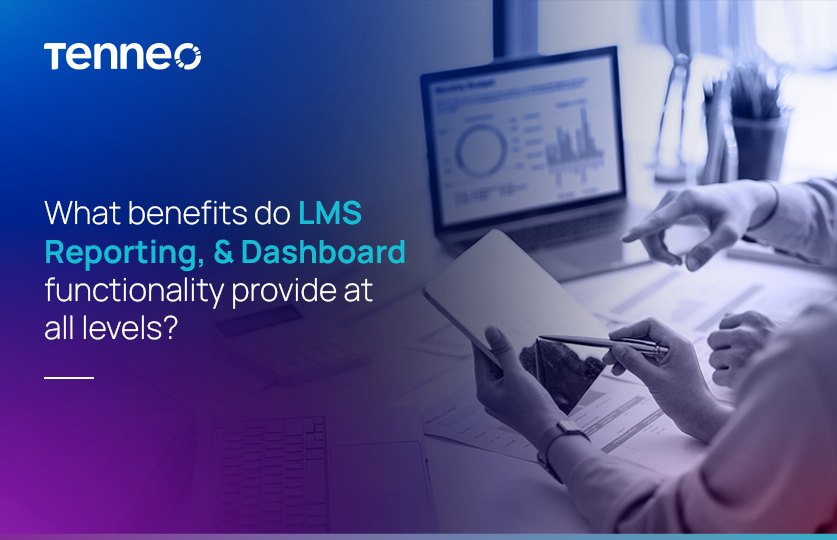
Tips to Consider for Improving Learning Culture in Organizations
April 13, 2023
What benefits Enterprise LMS provides for Employee Induction in the Retail Industry?
April 13, 2023
Tips to Consider for Improving Learning Culture in Organizations
April 13, 2023
What benefits Enterprise LMS provides for Employee Induction in the Retail Industry?
April 13, 2023Blog - 22 Mar 2023 | 6 Min
What benefits do LMS Reporting, and Dashboard functionality provide at all levels?

When going through the selection process of choosing a digital learning platform for their workforces, companies very often focus only on the basic and advanced functionalities such as – the capability to import existing information, handle & track training sessions’ progress, and management of the overall training process. However, data analytics features within the LMS are not given that much emphasis but on a ground basis, the data managed by an LMS, and its business values play a crucial role in decision-making by the leadership team.
The training data captured within LMS is available via detailed reports and pictorial dashboards that help the leadership team to get deeper insights, in turn letting them take informed decisions quickly. LMS reporting functionality not only provides employers but workforces with a comprehensive picture of the learning process. These insights provide everyone with the sense of direction required to plan and execute their learning journey and achieve professional growth.
LMS usage helps in making the training process more streamlined, however, reporting enables organizations to know if the entire learning activities achieved their purpose as defined. As per learning technologies, 82% of L&D managers said that reporting analytics is one of the most important features.
Let’s explore more about the LMS reporting and dashboard features and their benefits to all levels across the organization.
Tracking training course status and completion rate
LMS reports and dashboards present a pictorial view of the completion rate of training sessions for all users. This makes it easier for supervisors to keep track of their team members’ current assigned training and future training that is yet to be completed.
The LMS reporting functionality provides insights for various courses by identifying all the courses and comes with rankings as to which are performing the best, the lowest, and the average. This helps the administrators to review and design the new courses accordingly. This works as a metric to help you find the problems in the low-performing courses and identify the secret behind top-performing courses.
Track workforce training progress
The most obvious reason to use LMS reports is to keep track of workforce training status as completed and pending. These in-built reports are useful as they provide insights into where there is a need to improve your workforces’ skills, address any knowledge gaps, and ultimately enhance their performance. The overall progress tracking helps the supervisors with the in-depth analysis to prepare a futuristic learning path for their team members.
Measuring training content and Time-logs
Understanding and gauging learners’ interest is an important aspect, here LMS reporting helps in measuring the number of users opting for a particular set of courses. This approach helps the content owners with the inputs for existing courses while working on the new courses. The reports help in suggesting the highly opted courses and the least opted courses, basis which the content owners work to make changes in the content as applicable. Time logs of each training course provide an excellent insight into the difficulty level and effectiveness of the course. In case, more learners take longer time than expected, then those courses need to be addressed timely.
Increase learner engagement
Organizations do face challenges in keeping with learner engagement, they aim to opt for different ways to increase learner engagement. The LMS reports help with valuable insights to understand the way workforces learn as if they prefer videos, quizzes, or any other method. This way, content authors not only optimize the content of the courses but the methods of delivery as well. The organizations achieve the target of keeping their workforces more invested and excited about their learning helps significantly both with workforce retention and with improving company culture.
In a brief, the following functionalities of LMS reporting and analytics are beneficial
- Tracking overall progress and course completion rates.
- Measuring the popularity of courses and student involvement.
- Analyzing the assessments and survey results.
- Monitoring the time spent on training courses.
LMS reporting provides help in generating real-time reports where leaders can track down each learner’s progress by comparing their performance before and after completing the course. We at Tenneo (formerly G-Cube LMS), have 20+ years of experience in handling multiple industry-specific LMS needs. To know more about our range of products, contact us to connect with one of our experts.
Related services
Product Engineering
Other Blogs
Stay updated with Tenneo
When going through the selection process of choosing a digital learning platform for their workforces, companies very often focus only on the basic and advanced functionalities such as – the capability to import existing information, handle & track training sessions’ progress, and management of the overall training process. However, data analytics features within the LMS are not given that much emphasis but on a ground basis, the data managed by an LMS, and its business values play a crucial role in decision-making by the leadership team.
The training data captured within LMS is available via detailed reports and pictorial dashboards that help the leadership team to get deeper insights, in turn letting them take informed decisions quickly. LMS reporting functionality not only provides employers but workforces with a comprehensive picture of the learning process. These insights provide everyone with the sense of direction required to plan and execute their learning journey and achieve professional growth.
LMS usage helps in making the training process more streamlined, however, reporting enables organizations to know if the entire learning activities achieved their purpose as defined. As per learning technologies, 82% of L&D managers said that reporting analytics is one of the most important features.
Let’s explore more about the LMS reporting and dashboard features and their benefits to all levels across the organization.
Tracking training course status and completion rate
LMS reports and dashboards present a pictorial view of the completion rate of training sessions for all users. This makes it easier for supervisors to keep track of their team members’ current assigned training and future training that is yet to be completed.
The LMS reporting functionality provides insights for various courses by identifying all the courses and comes with rankings as to which are performing the best, the lowest, and the average. This helps the administrators to review and design the new courses accordingly. This works as a metric to help you find the problems in the low-performing courses and identify the secret behind top-performing courses.
Track workforce training progress
The most obvious reason to use LMS reports is to keep track of workforce training status as completed and pending. These in-built reports are useful as they provide insights into where there is a need to improve your workforces’ skills, address any knowledge gaps, and ultimately enhance their performance. The overall progress tracking helps the supervisors with the in-depth analysis to prepare a futuristic learning path for their team members.
Measuring training content and Time-logs
Understanding and gauging learners’ interest is an important aspect, here LMS reporting helps in measuring the number of users opting for a particular set of courses. This approach helps the content owners with the inputs for existing courses while working on the new courses. The reports help in suggesting the highly opted courses and the least opted courses, basis which the content owners work to make changes in the content as applicable. Time logs of each training course provide an excellent insight into the difficulty level and effectiveness of the course. In case, more learners take longer time than expected, then those courses need to be addressed timely.
Increase learner engagement
Organizations do face challenges in keeping with learner engagement, they aim to opt for different ways to increase learner engagement. The LMS reports help with valuable insights to understand the way workforces learn as if they prefer videos, quizzes, or any other method. This way, content authors not only optimize the content of the courses but the methods of delivery as well. The organizations achieve the target of keeping their workforces more invested and excited about their learning helps significantly both with workforce retention and with improving company culture.
In a brief, the following functionalities of LMS reporting and analytics are beneficial
- Tracking overall progress and course completion rates.
- Measuring the popularity of courses and student involvement.
- Analyzing the assessments and survey results.
- Monitoring the time spent on training courses.
LMS reporting provides help in generating real-time reports where leaders can track down each learner’s progress by comparing their performance before and after completing the course. We at Tenneo (formerly G-Cube LMS), have 20+ years of experience in handling multiple industry-specific LMS needs. To know more about our range of products, contact us to connect with one of our experts.



